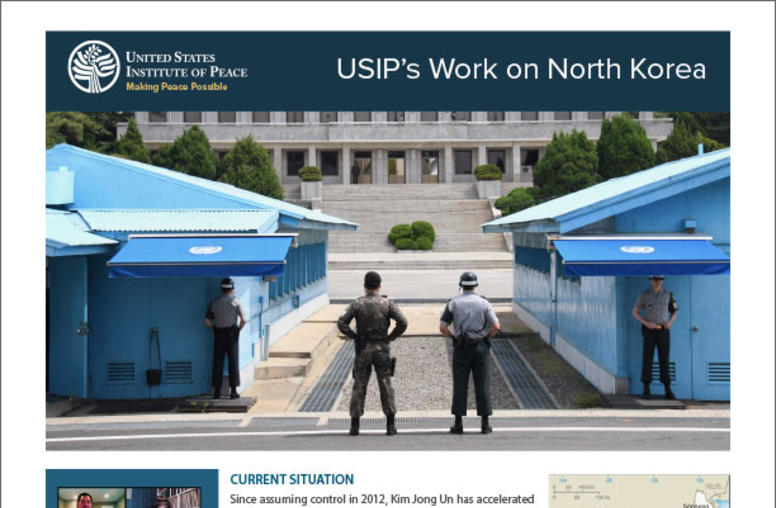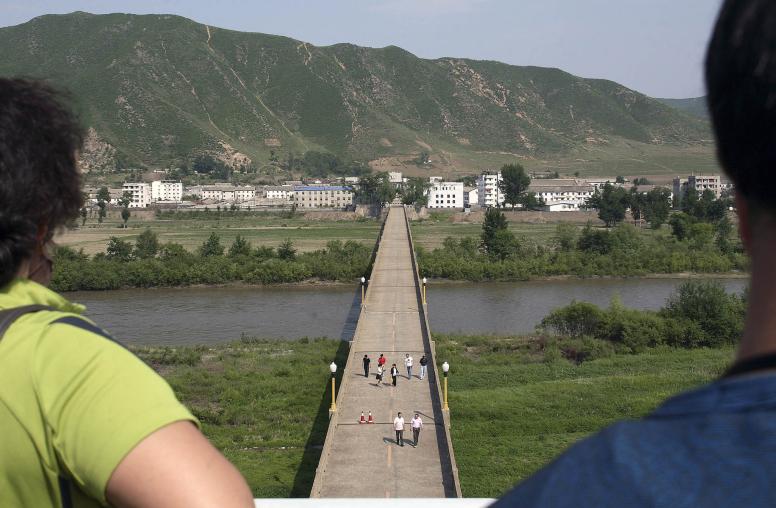70 Years After the Armistice, the Korean Peninsula Still Struggles for Peace
Political-military dialogue with North Korea is key to defusing military tensions and reducing nuclear risks.
On July 27, 1953, military commanders from the United States, North Korea and China signed an armistice agreement that ended the hostilities of the Korean War. The parties agreed to a “complete cessation of hostilities and of all acts of armed force until a final peaceful settlement is achieved.” They also recommended holding a “political conference” within three months for “the peaceful settlement of the Korean question.” After 70 years of truce, however, peace on the Korean Peninsula is still elusive.

With North Korea now possessing an expansive nuclear weapons program and threatening nuclear strikes and the U.S.-South Korea alliance countering with its own deterrence measures, the peninsula is rapidly becoming mired in a fresh crisis. Preventive diplomacy to keep this crisis from escalating into actual military collision and nuclear use, intentional or accidental, should be considered before it is too late.
Failed Attempts at Peace
The armistice agreement remains the only legally binding mechanism that maintains peace, though precarious, on the peninsula. North Korea and South Korea reconfirmed the validity of the armistice agreement as part of the historic 1991 Agreement on Reconciliation, Non-Aggression and Exchanges and Cooperation, known as the “Basic Agreement.” Under Article 5 of the Basic Agreement, both Koreas agreed to “endeavor together to transform the present state of armistice into a solid state of peace between the South and the North” and “abide by the present Military Armistice Agreement (of July 27, 1953) until such a state of peace has been realized.”
However, all efforts either to replace the temporary armistice with a peace agreement or to build a peace regime on the peninsula have failed. In 1954, a conference was held in Geneva based on the armistice agreement’s recommendation to hold a political conference to peacefully settle the questions of withdrawal of foreign forces from the Korean Peninsula and the divided political status of the peninsula. Despite appearing to have agreed on issues such as the removal of foreign forces and the holding of elections, the peace conference collapsed when the communist side rejected South Korea’s proposal to have the United Nations supervise the elections.
The 1991 Basic Agreement was another attempt by the two Koreas to build a peace regime. They agreed to recognize and respect each other’s systems, not to interfere in each other’s internal affairs, not to slander or vilify each other, not to use force against each other, and not to undertake armed aggression against each other. The Basic Agreement was essentially an inter-Korean peace agreement, if only both parties could keep their promises.
Another attempt at building a peace regime in the early 1990s focused on “four-party cross recognition.” The Soviet Union and China would recognize South Korea, and the United States and Japan would recognize North Korea simultaneously. But again, these efforts failed when the Cold War ended abruptly. The South Korean government changed its mind and stopped pursuing four-party recognition after it successfully normalized diplomatic relations with the Soviet Union and China in 1990 and 1992, respectively. On the other hand, North Korea failed to catch up. When North Korea refused to ride the global trends of opening and transformation, it was left behind and suffered serious economic and regime crises.
In 1996, the United States and South Korea proposed four-party talks with China and North Korea to replace the armistice with a peace treaty. However, these talks, which were hastily conceived by the alliance, also failed when North Korea proposed, and the United States rejected, including the withdrawal of U.S. troops on the agenda.
When a series of subsequent nuclear agreements with North Korea — the 1994 U.S.-DPRK Agreed Framework, the 2005 Six-Party Joint Statement and the 2018 U.S.-DPRK Singapore Joint Statement — collapsed, the possibility of building a peace regime slipped further away (North Korea is officially known as the Democratic People’s Republic of Korea, or DPRK).
Since the 1990s, North Korea has repeatedly tried to abrogate the armistice agreement so that it could expel U.S. forces from South Korea and dismantle the United Nations Command, the multinational military force established to support South Korea during and after the Korean War. North Korea even declared on several occasions that the armistice agreement was no longer valid. Regardless of such North Korean claims, however, all the relevant parties and the international community regard the agreement to be valid until it is replaced by a peace treaty.
The Rising Threat of War and Nuclear Risks on the Peninsula
Despite the armistice agreement, the two Koreas have engaged in constant military confrontation, conflicts, exchanges of fire and intrusions. But few thought that war was possible.
In 2017, however, the Korean Peninsula moved closer to war than ever. North Korea threatened South Korea and the United States with a “preemptive nuclear strike” and “war of annihilation.” The United States countered with threats of “fire and fury,” “bloody nose” strikes and “decapitation” operations. The environment shifted abruptly when a series of summits among U.S., South Korean, and North Korean leaders in 2018 raised expectations for a process to build a peace regime. After the United States and North Korea failed to reach an agreement in Hanoi in February 2019, the security situation on the Korean Peninsula returned to the usual normalcy of confrontation and conflict. But it became much worse due to the evolving dynamics of nuclear weapons.
A planned, full-scale war will not happen easily. But an accidental war, including nuclear use, has become thinkable on the peninsula for various reasons. First, North Korea’s questionable nuclear command and control and safety and security systems raise the risks of accidental nuclear use and proliferation. Additional factors such as one-man-centered launching decisions, a lowered nuclear-use threshold and a high-alert nuclear-launch posture further increase the chances of accidental nuclear use.
Second, there is a potential for collision between North Korea’s “preemptive nuclear strike doctrine” and South Korea’s preemptive “kill-chain” policy targeting a potential imminent nuclear attack from North Korea. When the preemptive strike policies of both parties are combined, the chances of military conflict with nuclear use become even higher.
Third, a combination of North Korea’s frequent, arbitrary missile tests and South Korea’s counter missile-firing demonstrations also tends to increase the chances of accidental military clashes between the two. In 2017, North Korea threatened to test fire medium- and long-range missiles at Guam and into the Pacific, over South Korea and Japan, to demonstrate its actual missile capabilities. If that happens again, South Korea, Japan and the United States may have to decide whether to intercept those missiles. In the worst case, they may have to decide to destroy those missiles preemptively before launch with very little information and time.
Recently, U.S. Joint Chiefs of Staff Chairman Gen. Mark Milley confirmed the potential for conflict on the Korean Peninsula in an interview with Japanese media. Noting that North Korean leader Kim Jong-un was unpredictable and North Korea's nuclear and missile threats were very real, Milley warned that the Korean Peninsula could be “in a state of war within a few days.”
From ‘Peace Through Dialogue’ to ‘Peace Through Strength’
The previous Moon Jae-in government in South Korea strenuously promoted peace with North Korea through engagement, including advocating for an “end of war” declaration as a critical initial step to building a peace regime. But despite North Korea’s initial interest in such a declaration, the United States never supported South Korea’s proposal. Later, North Korea stopped talking to South Korea when the former realized that the United States would not provide the relief from economic sanctions that it desired and South Korea seemed to promise.
As a result, North Korea returned to its traditional confrontational posture. At the Eighth Congress of the Workers’ Party of Korea in January 2021, North Korea declared a focus on advancing nuclear and military deterrence capabilities. In September 2022, the Supreme People’s Assembly promulgated the Law on the State Policy on Nuclear Forces that established more flexibility on the use of nuclear weapons. North Korea’s dangerous preemptive nuclear doctrine combined with diverse missile capabilities has heightened military tensions and nuclear risks on the Korean Peninsula.
In order to counter North Korean nuclear threats, South Korean President Yoon Suk-yeol’s government since May 2022 has strengthened the country’s deterrence capability individually and together with the United States. South Korea expanded investment in its three-axis defense system: preemptive strike, missile defense, and its concept of “massive punishment and retaliation.” In addition, South Korea resumed and expanded once reduced or suspended ROK-U.S. joint military exercises (South Korea is officially known as the Republic of Korea, or ROK).
Last April, Yoon and U.S. President Joe Biden adopted the Washington Declaration, which established a nuclear consultative group (NCG) aimed at strengthening consultations and coordination related to U.S. extended nuclear deterrence. The two countries held the first NCG meeting in Seoul on July 21 and announced that “any nuclear attack against the United States or its allies … will result in the end of [the North Korean] regime” and “any nuclear attack by North Korea against the ROK will be met with a swift, overwhelming, and decisive response.” The United States also sent the USS Kentucky, a nuclear-powered, ballistic missile submarine, to Busan from July 18-21, marking the first such visit in 40 years.
Seoul’s North Korea policy is now back to that of deterrence and pressure. We have witnessed this pendulum swing in North Korea policies before with changes in government. This time, tense relations and military confrontations may last longer. North Korea now possesses enough fissile material for about 30 to 50 nuclear warheads with advanced missile capabilities, and threatens to use them against South Korea. In addition, clouds of a cold war resulting from U.S.-China strategic competition and the Ukraine war overshadow the peninsula. A geopolitical fault line between the West and the East has begun resurfacing in Northeast Asia and across the peninsula.
In this new security and geopolitical environment, the South Korean and U.S. governments will focus more on building stronger deterrence to prevent war than building a peace regime on the peninsula. Yoon’s national security strategy calls for a strengthened ROK-U.S. combined defense posture and North Korean denuclearization prior to peace regime building. As Daniel Kritenbrink, the assistant secretary of state for East Asian and Pacific affairs, said at a U.S. congressional hearing on July 18, “rather than focusing on a peace treaty, I think we would rather focus on the immediate problem."
In Northeast Asia, and especially on the Korean Peninsula, military tensions are high and an arms race is in full swing. To deter and prevent nuclear threats and war by North Korea, strong deterrence is a must. On the other hand, there are growing concerns that nuclear risks and the potential for military collision are rising fast. Preventive diplomacy should be considered to keep these crises and risks from escalating into a military conflict that could involve the use of nuclear weapons. As part of such diplomatic efforts, the United States and South Korea must prioritize a political-military dialogue with North Korea to defuse military tensions and reduce nuclear risks.



